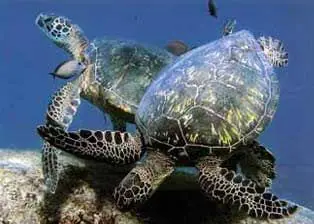Turtles are one of the oldest animals, and they first appeared on earth about 220 million years ago. At present, there are about 228 species and about 124 subspecies of turtles that have existed on the planet. They vary in their sizes, from miniature ones to giants that almost weigh half a ton! Here is a list of the top 10 turtles in terms of size and some key information about them.
11th Largest – Olive Ridley Turtle
- Maximum length: 2.3 feet or 70 cm
- Maximum weight: 110 lbs or 50 kg
- The scientific name of this turtle is Lepidochelys olivacea.
- This turtle is also known as the Pacific Ridley Sea Turtle.
- They are the second smallest and the most abundant turtle found in the world.
- This species of turtle has been found in the Indian Ocean, Pacific Ocean, and the Atlantic Ocean.
- The Olve Ridley Turtles are famous for their unique nesting behavior, where thousands of female turtles gather together on the same beach to lay their eggs.
10th Largest – Kemp’s Ridley Sea Turtle
- Maximum length: 3 feet or 90 cm
- Maximum weight: 110 lbs or 50 kg
- The scientific name of this turtle is Lepidochelys kempii.
- This turtle is also known as the Atlantic Ridley Sea Turtle.
- This species is the rarest of the sea turtles, and at present, its population count is critically endangered.
- This turtle species is named after Richard Moore Kemp, who sent this specimen to Samuel Garman at Harvard.
- This turtle prefers to live in areas with warm waters, and they are most commonly seen in New Jersey and Louisiana.
- The Kemp’s Ridley Sea Turtle enjoys eating jellyfish, mollusks, fish, seaweed, and algae.
9th Largest – Flatback Sea Turtle
- Maximum length: 3.12 feet or 95 cm
- Maximum weight: 185 lbs or 84 kg
- The scientific name of this turtle is Natator depressus, but its former taxonomical name was Chelonia depressa.
- This turtle is native to the shallow coastal waters and sandy beaches of Australia.
- This turtle is named from the character of its shell that has a lowered dome that is flattened compared to other sea turtles.
- Unfortunately, the IUCN Red List classified this turtle as Data Deficient, which means much research has yet to be completed about this specific species.
- The colors of this turtles are visible as grey and olive green with a cream color in their underside.
- The flatback sea turtles are often preyed upon by pigs, dogs, sharks, and foxes.
8th Largest – Black Sea Turtle
- Maximum length: 3.28 feet or 100 cm
- Maximum weight: 278 lbs or 126 kg
- This species of turtle is known as green sea turtle, Pacific green turtle, and green turtle.
- Black sea turtles can be found in the eastern tropical Pacific and cannot be commonly found in the open ocean.
- Black sea turtles are known to inhabit shorelines and bays from countries all around the globe.
- The scientific name of these turtles is Chelonia mydas agassizi.
7th Largest – Hawksbill Turtle
- Maximum length: 3.28 feet or 100 cm
- Maximum weight: 127 kg or 280 lbs
- The scientific name of this species is Eretmochelys imbricata.
- This turtle is classified as critically endangered.
- The hawksbill turtle has unique shells that change colors depending on the water temperature.
- This species of turtles are famous for existing in an extensive range, which involves the Atlantic Ocean, Indian Ocean, and the Pacific Ocean.
- Hawksbill turtles are primarily found in tropical color reefs, ledges, caves, lagoons, and mangrove swamps.
- These turtles primarily feed on sea sponges, and this species constitute 70 percent to 95 percent of the diet of these turtles. They usually eat sea anemone, cnidarians, comb jellies, jellyfish, and other related animals.

6th Largest – Alligator Snapping Turtle
- Maximum length: 81 cm or 2.66 feet
- Maximum weight: 403 lbs or 183 kg
- The scientific name of this turtle is Macrochelys temminckii.
- This turtle is native to living in freshwater habitats all over the United States.
- This species was given their name because of their immensely powerful jaws and distinct ridges that are very similar to the ridged and rough skin of an alligator.
- Some people call this species of the turtles like the loggerhead snapper.
- The Alligator Snapping Turtle is primarily found in the states of Florida, Texas, South Dakota, Missouri, Tennessee, Indiana, Iowa, and Kansas.
- This turtle can also be characterized by their large, heavy head, thick shell, and their primitive appearance.
- Alligator snapping turtles are carnivorous species that rely on food they caught themselves as well as some dead organisms that they scavenge. They love eating turtles, crayfish, molluscs, carrion, water birds, and some aquatic plants.
5th Largest – Aldabra Giant Tortoise
- Maximum length: 4.90 feet or 150 cm
- Maximum weight: 794 lbs or 360 kg
- The scientific name of this turtle is the Aldabrachelys gigantea.
- Originally, these species reside in Madagascar, the Indian Ocean islands, and many other islands all over the world.
- The main community of these animals can be found of the Aldabra Atoll in Seychelles.
- These turtles are primarily known as herbivores, which means that they eat woody plant stems, leaves, and grasses. In captivity, they also eat apples, bananas, and vegetable pellets.
- These tortoises have proven to be one of the longest living animals, with some reaching about 200 years of age.

4th Largest – Galapagos Tortoise
- Maximum length: 6.14 feet or 187 cm
- Maximum weight: 880 lbs or 400 kg
- Modern Galapagos tortoises only exist in the Galapagos Islands, which is a volcanic archipelago about 1,000 km west of Ecuador.
- These turtles were discovered in 1535, but they first appeared on the maps of Abraham Ortelius and Gerardus Mercator in 1570.
- The Galapagos tortoises are known to be ectothermic, meaning they are cold-blooded, which leads to basking for 1 to 2 hours after dawn to absorb the heat of the sun before foraging for food about 8 to 9 hours in a day.
- These tortoises are herbivores that eat berries, melons, cacti, leaves, milkweed, and oranges.
3rd Largest – Green Sea Turtle
- Maximum length: 4.6 feet or 140 cm
- Maximum weight: 1,100 lbs or 500 kg
- The black sea turtle is endemic into tropical seas all over the world, which includes the Indian Ocean, Atlantic Ocean, and the Pacific Ocean.
- The scientific name of this turtle is Chelonia mydas.
- This species got their name from the green-colored fat that can be found beneath their carapace and their shells that are colored black.
- The black sea turtle is mostly herbivorous, and it adores eating seagrasses in the shallow lagoons where they usually stay.
- This species is listed as endangered in IUCN’s Red List and is usually protected by most laws against exploitation and illegal trade.
- If they survive as hatchlings, these turtles can live up to 80 years in the mind.
2nd Largest – Loggerhead Sea Turtle
- Maximum length: 7 feet or 213 cm
- Maximum weight: 1,202 lbs or 545 kg
- The scientific name of this turtle is Caretta caretta, and this is also famous for the nickname ‘loggerhead.’
- The loggerhead sea turtle is most commonly found in the Mediterranean Sea, Indian Ocean, Atlantic Ocean, and the Pacific Ocean.
- This turtle spends most of their lives living in estuarine and saltwater habitats.
- Loggerhead sea turtles are known for their low reproductive rate, as females who lay, a clutch of four eggs cannot bear a child for another two to three years.
- These turtles reach their maturity at 17 years old, and their lifespan can range from 47 to 67 years.
- The loggerhead sea turtles are classified as Vulnerable by the IUCN Red List, because of intensive hunting for their eggs and meat.

1st Largest – Leatherback Sea Turtle
- Maximum length: 6.90 feet or 210 cm
- Maximum weight: 1,430 lbs or 650 kg
- The scientific name of this turtle is Dermochelys coriacea.
- This turtle is also known for the names of leathery turtle, luth, and lute turtle.
- This leatherback sea turtle can be easily differentiated from other kinds of sea turtles by the lack of their bony shell, thus their name.
- This species was first discovered in 1761 by Domenico Agostino Vandelli.
- The leatherback turtles have the most hydrodynamic body if you compare them with other sea turtles, and they are shaped like a teardrop.
- The leatherbacks can reach as far as Alaska, Norway, Africa, and New Zealand. Their main populations are present in the Western Pacific, Eastern Pacific, and the Atlantic Ocean.
- These turtles feed on almost entirely on jellyfish. They also feed on other types of soft-bodied organisms like cephalopods and tunicates.
- Some reports claim that these turtles live up to 30 years, but some believe that they can live up to 100 years.



